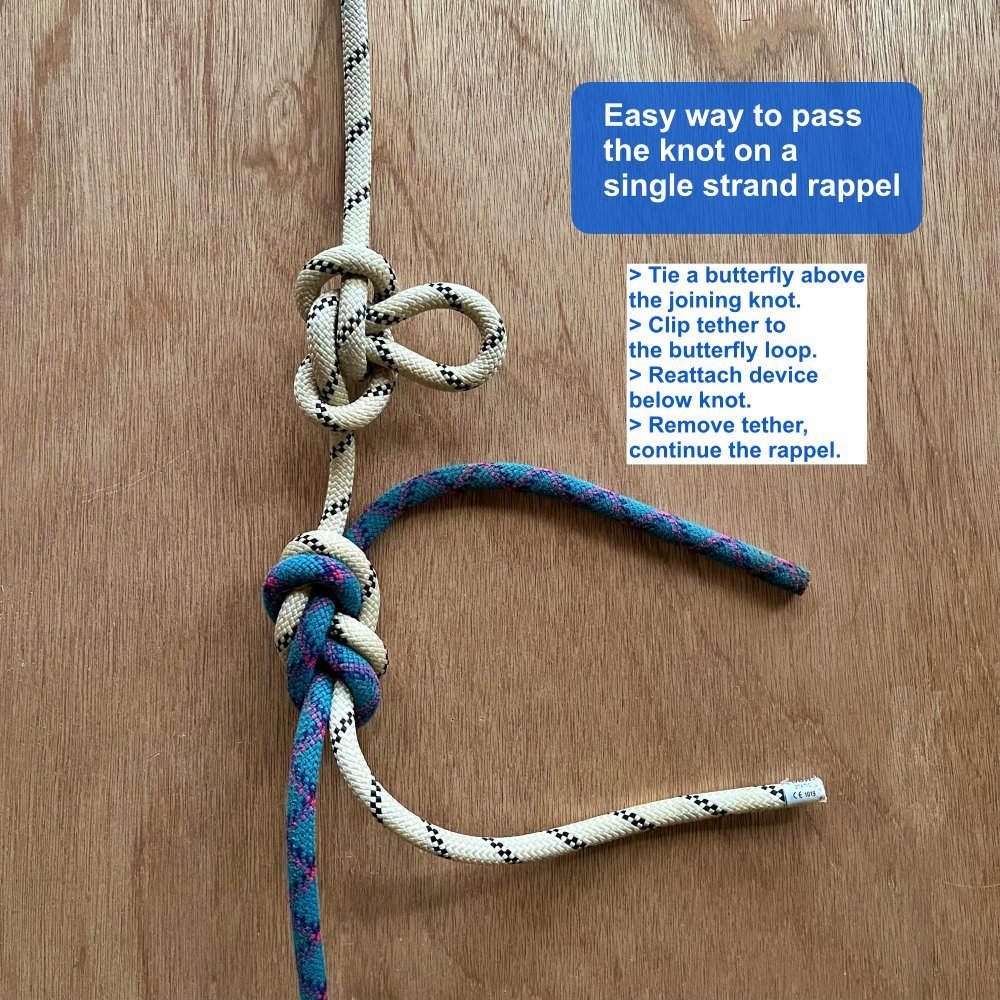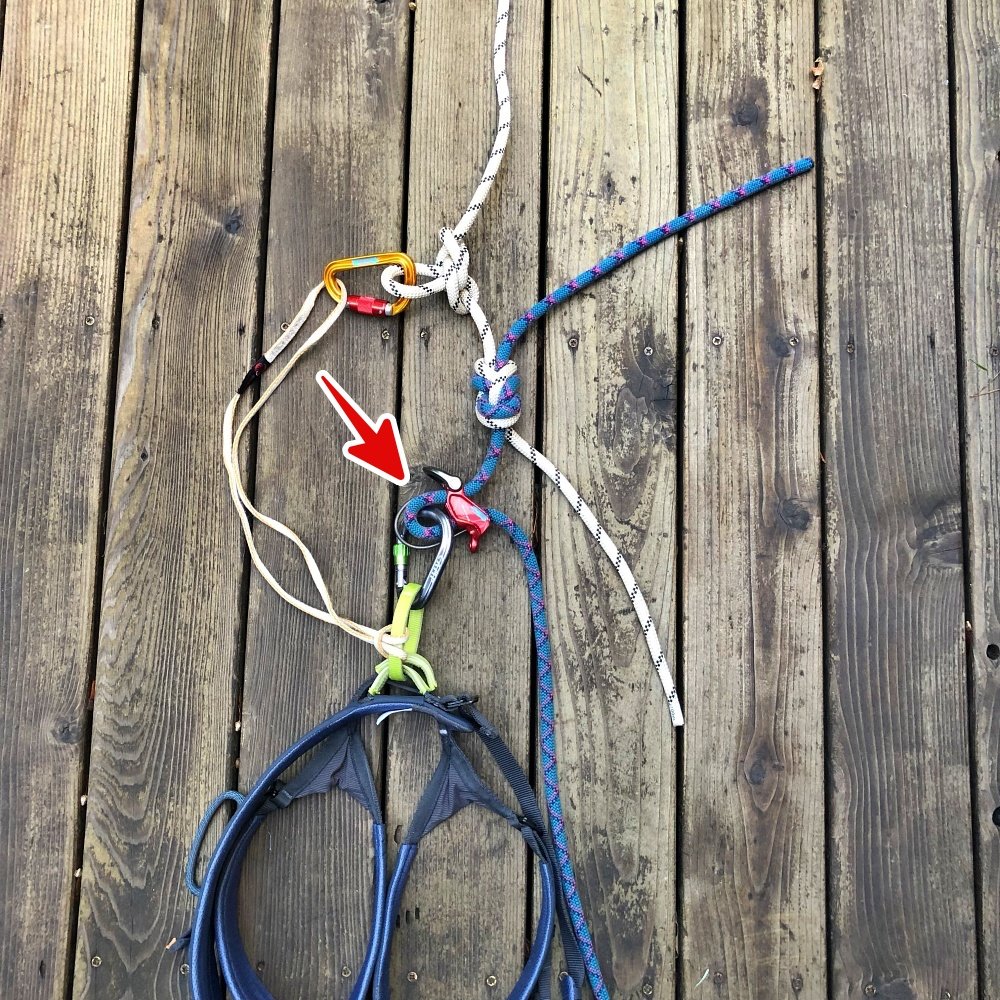Easy way to pass the knot on a single rope rappel
This tip was written with the help of Bryan Hall, who is certified by the Society of Professional Rope Access Technicians (SPRAT) at their highest level. Connect with Bryan at www.rosecityropes.com
Note - This post discusses techniques and methods used in vertical rope work. If you do them wrong, you could die. Always practice vertical rope techniques under the supervision of a qualified instructor, and ideally in a progression: from flat ground, to staircase, to vertical close to the ground before you ever try them in a real climbing situation.
Short version:
You’re rapping on two ropes tied together in a single strand, and you need to pass the knot connecting the ropes to make it all the way down. (For some scenarios when you might need to do this, keep reading.)
Solution: Tie a butterfly knot just above the knot connecting your ropes. Use the butterfly loop as a ready-made clip in point when you’re passing the knot.
We're trying to keep it simple in this example, so we’ll assume you're on something less than completely vertical or free hanging terrain. On something less than vertical, you can momentarily “batman” down the rope to reattach your device as shown below, and hopefully also step up for a moment to unclip your tether.
If things are completely vertical, it gets a bit more complicated, more on that below.
What about passing the knot if you have a standard double rope rappel? Well, with some knowledge of Crafty Rope Tricks, you should pretty much never have to do this! Learn more at this article.
When might you need to rappel on two ropes tied together in a single strand?
You’re between one and two rope lengths up on a climb, and you have some sort of emergency situation: injured person, incoming lightning storm, impending darkness, whatever, and you just want to get to the ground ASAP and leave your ropes to get later.
You have two or more rope lengths below you on moderate terrain (4th class rock; steepish snow) that at least one person on your team is comfortable downclimbing without a rope. You send your whole team down on the two ropes tied together. The last person unties the rope, tosses it, and solo downclimbs. (or “downleads” by cleaning gear left by the next to last person. (Learn more about downleading here.)
You’ve fixed two or more rope lengths up to the high point on a big wall, and you’re rapping back down to the bottom. In a day or two, you’ll come back, ascend your ropes, and continue with the route.
You’re descending fixed ropes that someone else set up, like descending from Heart Ledge, Sickle Ledge or the East Ledges on El Capitan.
Anyway, those are some not-so-normal-but-entirely-plausible scenarios where you might need to pass the knot on a single rope. Can you think of any others?
Two ropes connected with a Flemish bend, with a butterfly loop in the “upper” rope so you can safely pass the knot. Try to tie this butterfly as close to the Flemish bend as you can.
The butterfly is one option; any bight knot will work. The Flemish bend is preferred for a single strand rappel over the flat overhand bend, which is a standard for rappelling on two strands.
1) Before you start down, girth hitch a clip a short (60 cm sling or PAS) tether to your harness, and clip it with a locking carabiner. Rappel down the upper rope, and stop when you get just above the butterfly.
2) Clip your pre-tied tether into the butterfly loop; remember to lock it. Nice, you're now secured to the upper rope with your tether.
3) Remove your rappel device from the upper rope. Yes, this will require you to get some kind of stance for your feet to unweight the rope a little bit. (If this steep or you're scared, you could tie a catastrophe knot in the bottom rope and clip it to your harness as a backup.)
4) Downclimb or “batman” down the rope until you're below the joining knot. Reattach the rappel device to the bottom rope.
5) Unclip your tether and continue with the rappel. Schweeet, you just passed the knot!
Typically, this is set up with just a knot connecting the two ropes, such as a rewoven figure 8 bend, also known as the Flemish bend, or simply a flat overhand bend.
Sure, these knots are safe enough, but it sure doesn’t give you any assistance when you need to get past the knot. This is the beauty of adding the butterfly loop - you have a ready-made, secure point to attach a short, repeat, SHORT, leash to add an instant safety when you’re transferring your belay device from the top rope to the bottom rope.
This process is MUCH easier if you can find a small stance for your feet so you can momentarily take your weight off your rappel device. This should typically be possible on steep snow, ice, or low fifth class rock.
If you’re trying to pass a knot on a completely free hanging rappel, things get more complicated. You typically would add a friction hitch or ascender above the knot, weight that, remove your rappel device and reattach it below the knot, unweight the friction hitch / ascender, remove it, and continue rappelling. If you find yourself having to do this in a very steep terrain, you’re probably a caver or big wall climber, have an ascender, aid ladder or other helpful gear, and have already practiced this technique. Even so, the butterfly knot can still give you a handy place to clip for additional security.
What about using a flat overhand bend on a single strand?
If you use a standard flat overhand bend here instead of the Flemish bend or a more robust knot, you're probably gonna be fine. However, it's not best practice for a single strand rappel. Here's a much longer article examining this issue.
Safety note: keep your rope tails about 30 cm
Typically, when tying two ropes together for a rappel, you tie the knot with long tails, at least one foot. Some folks do it closer to two feet (the extra length doesn’t make them any safer or stronger, but it might add a little psychological boost.)
However, anytime when tying two ropes together like this, you want to AVOID using very long tails. Reason: the person rappelling could make the fatal mistake of reattaching their belay device onto the tail(s), instead of the actual rope. Yes, it has happened. It probably sounds like a mistake you would never make if you’re reading this indoors on a nice sunny day, but if it’s at night, raining, in a cave, you’re physically and mentally fried, whatever, simple mistakes like this can happen all too easily.
Here's a longer article on this topic.
The better practice is:
Tie your knot to connect the ropes, and keep the tails about 30 cm / 12-16 inches max (or, about the length of your forearm.)
Tidy the knot properly, then snug it down (aka “dress it and stress it.”)






